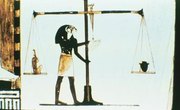Lady Justice is a common sight on courthouses and legal institutions. There is regional variation on her precise depiction, with certain depictions featuring different styles of clothing, head coverings, and a variety of facial expressions, but certain fundamentals are constant to the statues and other images: She carries a sword, scales for weighing, and usually (though not always) wears a blindfold. She is garbed in a Greco-Roman toga or tunica, in the tradition of classical goddesses, philosophers and prophets. Images of her can be found across the world.
History of Lady Justice
The concept of a goddess of justice is old indeed, dating to ancient Egyptian and Greek times. The Egyptians had Ma'at, who stood for order and carried both a sword and the Feather of Truth. The Greeks had the goddess Themis, who stood for law, order and justice (and who, incidentally, was mother to the Fates, who themselves were noted for judging humanity).
The Roman goddess of justice, Justitia, is the most direct inspiration, since she carried the sword, scales and blindfold we are familiar with today, and could often be found depicted outside legal institutions.
The Scales of Justice
The scales of justice date back to Egyptian times, where the god Anubis was invariably depicted with a set of scales to weigh a deceased person's soul against the Feather of Truth. The modern interpretation filters through the Enlightenment's focus on reason, as Lady Justice weighs the factors of a case to render a verdict. The scales imply a mechanistic, rational process; too much weight (evidence) on one side will cause the scales to tilt in favor of innocence or guilt.
Lady Justice's Sword
Lady Justice often carries a sword in one hand. The sword is a historical symbol of authority, wielded by kings, emperors and generals. It is therefore one of the earliest symbols for justice, as the power of a monarch could be delivered with a stroke of the sword. Additionally, the sword has an esteemed place in ceremony even today, as people who are knighted are touched upon the shoulders with a blade. Lady Justice's sword advances the concept that justice can be swift and final.
Concept of Blind Justice
The blindfold she wears symbolizes the philosophy that justice should be rendered "without passion or prejudice." Considering only the facts on her scale, Lady Justice does not bother with letting emotional impressions of the accused enter into the implicit equation. All are fair before the facts of the case and the judgment of Justice. Not all depictions of Lady Justice feature the blindfold, however. The striking feature was only popularized in the late 15th century – but even after the blindfold's wide adoption by artists, certain cities and countries would depict Lady Justice without the blindfold: this was often done to urge judges to assess cases with their "eyes open" and pay mind to the individuals involved in addition to the letter of the law. Cities with older statues would also argue that Lady Justice's "maidenly form" already implied impartiality, refusing to update images to add blindfolds.
Other Noteworthy Features
Lady Justice wears the garments of classic Greece and Rome. This owes to her origins as an interpretation of Justitia. It also serves to underscore the place of the toga in western tradition; such garments represented civilization and philosophy. A popular expression in ancient Rome was: "Cedant arma togae," which means "Let arms (war) give way to the toga (civil power)."
Lady Justice Today
Though the exact details of her appearance may vary, Lady Justice is still a popular and well-understood cultural figure. In addition to the statues and images that display her in front of civil institutions, Lady Justice is commonly depicted in art – particularly art with political messages, such as political cartoons or modern protest art. Often, she is used as a character set in various situations, meant to depict the law as a living, breathing thing that can be changed – or in a number of depictions, restricted, undermined, or preyed upon. Occasionally, her features are blended with those of the Statue of Liberty to depict situations specific to the United States.











